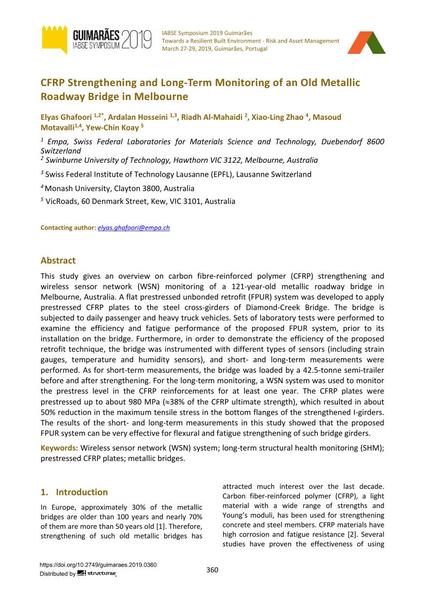CFRP Strengthening and Long-Term Monitoring of an Old Metallic Roadway Bridge in Melbourne

|
|
|||||||||||
Détails bibliographiques
| Auteur(s): |
Elyas Ghafoori
(Empa, Swiss Federal Laboratories for Materials Science and Technology, Duebendorf 8600 Switzerland; Swinburne University of Technology, Hawthorn VIC 3122, Melbourne, Australia)
Ardalan Hosseini (Empa, Swiss Federal Laboratories for Materials Science and Technology, Duebendorf 8600 Switzerland; Swiss Federal Institute of Technology Lausanne (EPFL), Lausanne Switzerland) Riadh Al-Mahaidi (Swinburne University of Technology, Hawthorn VIC 3122, Melbourne, Australia) Xiao-Ling Zhao (Monash University, Clayton 3800, Australia) Masoud Motavalli (Monash University, Clayton 3800, Australia) Yew-Chin Koay (VicRoads, 60 Denmark Street, Kew, VIC 3101, Australia) |
||||
|---|---|---|---|---|---|
| Médium: | papier de conférence | ||||
| Langue(s): | anglais | ||||
| Conférence: | IABSE Symposium: Towards a Resilient Built Environment Risk and Asset Management, Guimarães, Portugal, 27-29 March 2019 | ||||
| Publié dans: | IABSE Symposium Guimarães 2019 | ||||
|
|||||
| Page(s): | 360-368 | ||||
| Nombre total de pages (du PDF): | 9 | ||||
| DOI: | 10.2749/guimaraes.2019.0360 | ||||
| Abstrait: |
This study gives an overview on carbon fibre-reinforced polymer (CFRP) strengthening and wireless sensor network (WSN) monitoring of a 121-year-old metallic roadway bridge in Melbourne, Australia. A flat prestressed unbonded retrofit (FPUR) system was developed to apply prestressed CFRP plates to the steel cross-girders of Diamond-Creek Bridge. The bridge is subjected to daily passenger and heavy truck vehicles. Sets of laboratory tests were performed to examine the efficiency and fatigue performance of the proposed FPUR system, prior to its installation on the bridge. Furthermore, in order to demonstrate the efficiency of the proposed retrofit technique, the bridge was instrumented with different types of sensors (including strain gauges, temperature and humidity sensors), and short- and long-term measurements were performed. As for short-term measurements, the bridge was loaded by a 42.5-tonne semi-trailer before and after strengthening. For the long-term monitoring, a WSN system was used to monitor the prestress level in the CFRP reinforcements for at least one year. The CFRP plates were prestressed up to about 980 MPa (38% of the CFRP ultimate strength), which resulted in about 50% reduction in the maximum tensile stress in the bottom flanges of the strengthened I-girders. The results of the short- and long-term measurements in this study showed that the proposed FPUR system can be very effective for flexural and fatigue strengthening of such bridge girders. |
||||
